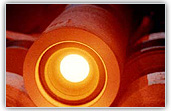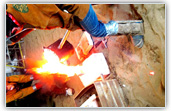| Process |
| Manufacturing Process In Foundry |
|
|
 |
Dual Track Induction Furnaces OF 300 Kgs. are installed in the section of Melting for processing in foundry. We melt metal in Induction Furnaces which is added with chemicals like Chromium, manganese, carbon, molybdenum, sulfur and many more as per customer’s requirement enabling to maximize the strength of the product. Induction Melting is used for best quality material production through chemical composition and micro structure.
|
|
|
|
|
|
 |
Melted material is poured in rotating die (centrifugal) to get a specific structure of casting as per the drawing or requirement. The outer shape is set through this process. We also add some additives / chemicals to get defect free casting and this process is done mainly by big ladle pouring and industrial pouring as per the weight of the casting.
|
|
|
|
|
Centrifugal Process for Casting |
|
|
 |
The centrifugal casting process gives defect-free castings. This is with best wear resistance. The process is carried out in integration and co-ordination with the induction melting process. The Centrifugal Casting Process assures minimum structural variations, dimensional accuracy, concentricity and stability, thereby complying to any Global Standards of Grey Cast Iron. Overall, this process is vitally important for wet and dry liners.
|
|
|
|
|
|

|
We have Shell Mould Casting Facility in our foundry premises. This infrastructure is also vitally important for air cooled blocks and many more. |
|
|
|
| Manufacturing Process in workshop |
|
|
| |
CNC Machinery is deployed along with other machines for Machining. Proof-machining is done as a regulation in our plant to attain accuracy at all levels. Complete OD profile is done in one single setup on CNC machines with special jelly type expanding mandrills, so that a uniform expansion, concentricity and squareness is achieved with very close tolerance.
|
|
|
|
|
|
| |
Grinding is done on centre less grinders where all the collars of liners are grinded simultaneously to maintain parallelism on all the diameters profiles to a minimum and also ovality to a minimum.
|
|
|
|
|
|
| |
Vertical boring machines are used for final boring. This machining process provides an accuracy of 0.010 in ID.
|
|
|
|
|
|
| |
We pioneered and implemented the PLATEAU Honing Process in India, over the usual honing processes. This gives optimum finishing by removing peaks and retaining valleys, using the Double Expansion Plateau Honing machines.
The benefits of PLATEAU Honing are,
- Increased life of piston ring.
- Reduced oil consumption (to as much as 30%).
- Increased engine performance and life.
- Reduced engine running-in period.
SLIDE Honing is another removal mechanism developed by us that avoids sliding stresses during the engine running-in period.
Highly qualified Engineers are employed to exploit and maintain this state-of-the-art plant, to produce the best products.
|
|
|
|
| |
| Technical Parameters: |
Material Standard IS 210, GG25, ASTM A48 but can be deviated according
to customer requirements. |
| Hardness |
210 – 275 BHN |
| Tensile |
25kgf/sq. mm |
| Graphite |
Type A & B (D&E Random) |
| Flake Size |
4-6 |
| Free Ferrite |
Less than 3% |
| Matrix |
Fine Lamellar & Sorbitic Pearlite |
| Surface Roughness |
Ra 0.4 to 0.8 micron Rz 4 to 7 micron Vo 0.16 to 0.45 |
|